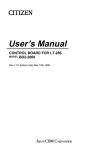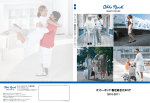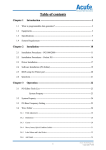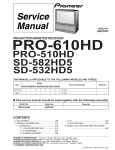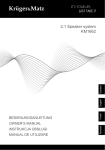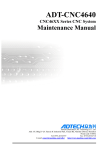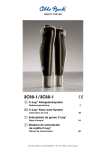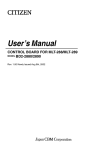Download Art-Tech R/C Hobby Specifications
Transcript
ANGEL Remote control helicopter Operating manual R CATALOG ★SPECIFICATIONS 02 ★CAUTION 03 ★TIPS FOR SAFETY 03 ★CHARGE MODE AND WARNING 05 ★SAFETY INSTRUCTIONS FOR LI-POLY BATTERIES 06 ★PARTS LIST 07 ★OPERATION MANUAL METHOD STARTING PROCEDURE 07 ★FUNCTIONS FOR CONTROL SET 08 ★ADJUST THE SPEED OF THE ROTOR BLADES BY THE PCB BOARD 08 ★SWASHPLATE ADJUSTMENT 09 ★MAIN ROTOR BLADE ADJUSTMENT 09 ★GROUND EFFECT 09 ★NORMAL FLIGHT 10 ★INSTALLATION 11 ★PARTS REPLACING 13 ★THE POSSIBLE PROBLEMS AND SOLUTIONS 14 ★SPARE PARTS LIST 15 ★中文说明部分 17-31 1 www.art-tech.com Thank you for purchasing our latest product--Angle 300 electric R/C helicopter. This helicopter is a typical coaxial dual rotor helicopter and it’s our latest product. The frame is made of the high-strength plastic and configured with scale flashers for night flight. This helicopter is super stable, easy to control and it has a great maneuverability and accuracy. Moreover, this product has a vivid flying gesture and it is crashresistant. The flying time of each charge is more than 10min and it is an optimal model for the beginners. For the safety operation of this helicopter, please make sure to read this manual carefully and follow all of the safety notes strictly. ※This picture only for reference. SPECIFICATIONS: ★ Rotor diameter : 350mm ★ Optimal helicopter for the beginner ★ Length: 430mm ★ Flying condition: indoor without wind ★ Height: 190mm ★ Coaxial counter-rotating structure ★ Weight: 260g ★ Easy control and stable flight ★ 4 channel 2.4GHz radio system ★ Balance charger CONFIGURATION: ★ Flying time: 10 mins ★ 4 channel 2.4GHz radio system ★ 180 class brushed motor PRODUCT CHARACTER ★ Li-Poly battery: 7.4V 1000mAh Accomplishment 100% ★ 2 pcs 8g servo Difficulty of assembly ★☆☆☆☆ ★ 4 pcs blades Difficulty of maintain ★★★☆☆ Difficulty of control Anti-shatter ★★☆☆☆ ★★☆ ★★☆ WARNING: This product is for the ones that are above 14 years old. Children should be supervised prior to starting or flying this helicopter. Don’t touch the propellers after the product turned on. ※Specifications may change without notice, please refer to the real one for configuration. 2009.06 2 www.art-tech.com CAUTION R/C modeling is a hobby with high technology and should not be considered as a toy. There is risk involved during the operation of this product and the user should take all precautions seriously or serious body injury may occur, it is only suitbale for the person above 14 years old. Improper disassembly, improper adjustments or setup may lead to unsatisfactory or unsafe operation. If you have any questions regarding the use, maintenance, or safe operation of this model, please contact your local retailer. NOTE As with any R/C product there are risks involved when flying this model. A beginner should seek the help of a skilled R/C pilot to ensure that the model is airworthy and capable of safe operation. Any damage, neglect, or unfamiliar use of this product can cause unexpected accidents or injury. Please make sure the flying is safe and we are not responsible for any accident. TIPS FOR SAFETY 1. Locate an appropriate place to fly your helicopter: R/C helicopters are capable of flying at high speeds, thus posing a certain degree of potential danger to both the flyer and bystanders, so it is important to choose a right site for flying. First, the space of flying site should be big enough (at least 4*4*4m). Second, the flying site should be open enough, and clear of obstacles. Do not fly your helicopter during the strong counter-flow weather to avoid the unnecessary damage. T h i s R C h e l i c o p t e r, a n g e l 3 0 0 , h a v e t h e b e s t p e r f o r m a n c e i n t e r m s o f c o n t r o l c a p a b i l i t y a n d scalability without wind. it may not fly properly outside due to the fluency of airflow so that it is not r e c o m m e n c e d t o f l y o u t d o o r. Without wind 3 www.art-tech.com TIPS FOR SAFETY 2. Obtain the assistance of an experienced pilot. The help of an experienced pilot will ensure that you will have a well trimmed, correctly functioning helicopter for the first flight. It is strongly advised that you first practice on the simulator prior to making a flight with your new helicopter. Novice Novice 3. Always be away from the running parts During the operation of your helicopter the rotor will be spinning at a high rate of speed. Don’t touch any running parts and please keep a proper distance with them. Be conscious of your actions and be careful to keep your hands, face, eyes, and loose clothing away from the blades and gears to avoid being hurt or any damage to the model. 4. Keep your helicopter away from humidity. Your new Angle 300 helicopter is a hi-tech electronic device, so try to keep the model away from the humidity condition which may result in the operation errors or some other unrespectable faults to the model. Never subject your model to severe weather, such as raining, thunder. 5. Operate your helicopter gently The helicopter will give a prompt response to the controlling action,so try to operate the helicopter gently. Try to avoid the excessive operation as this may lead to the helicopter to be out of control. 4 www.art-tech.com Expert CHARGE MODE AND WARNING Li-Po battery(balance changer) ATI-0910 Li-poly battery balance charger using instruction 12V D C Power supplier Specifications: Input voltage: DC 10V~15V Output voltage: DC 7.4V&11.1V (To 2 or 3 cell Li-poly battery) Charge current: 0.3A~1.0A (Can be continuously adjusted) Indicator state: Green: Charge complete or no battery Red: Charging Flash: Drip current charging Separated battery detection: The voltage of any battery reaches 4.2V, the charge of it will cease automatically. Using method: 1. Connect the cigarette with charger per above image 2. Then plug cigarette into its socket in car (Adapter should be connected if charge at home: connect the adapter to home power socket, then plug the adapter’s DC end to charger). The LED will turn green indicating it is ready for charging. 3. Connect the battery to the charger per its interface mark. The LED becomes red, which means the battery is on the way. 4. Adjust the charge current. In order to prolong battery’s life-span, we recommend charging them under low current if you have enough time. 5. When the LED flashing, the charger will enter the stage of drip current charging. The LED turns green when fully charged, and the battery will be used at any time. Notice 1. Do not insert any conductive into the cooling hole when power is on, or damage will be caused to the charger. 2. While charging is in process, please do not place it near flammable materials. 3. It is not allowed to charge two-cell and three-cell Li poly battery at the same time. 4. Expect Li poly battery, this charger is not allowed for other kinds of battery. 5. While charging, please keep it out of the reach of Children. 6. When this charger is in use, please do not go away and leave it unwatched, if any abnormality occurs (such as the power indicator is off, the temperature of the battery rise rapidly, etc.) stop charging immediately. 7. Please do not use power with output voltage higher than 15V. 8. Please do not disassemble the charger or its accessories. 9. When the battery is not cool down, please do not urge to charge it. 5 www.art-tech.com SAFETY INSTRUCTIONS FOR LI-POLY BATTERIES 01.Do not disassemble or reconstruct the battery. 02.Do not short-circuit the battery. 03.Do not use or leave the battery nearby the fire, stove or heated place. 04.Do not immerse the battery in water or sea water, do not get it wet. 05.Do not charge the battery nearby the fire or under the blazing sunlight. 06.Do not drive a nail into the battery, strike it by hammer or tread on it. 07.Do not impact or throw the battery. 08.Do not use the battery with conspicuous damage or deformation. 09.Do not make the direct soldering on the battery. 10.Do not reverse charge or over discharge the battery. 11.Do not reverse charge or reverse connect. 12.Do not connect the battery to the ordinary charger socket or car cigarette jack. 13.Do not use the battery for unspecified equipment. 14.Do not touch the leaking battery directly, please wash your skin or clothes with water if they are bedewed by liquid leaking from the battery. 15.Do not mix the Li-Poly battery with other un-chargeable battery . 16.Do not continue charging the battery over the prescribed time. 17.Do not put the battery into the microwave oven or high-pressure container. 18.Do not use the abnormal battery. 19.Do not use or keep the battery under the sunlight. 20.Do not use the battery nearby the place where generates static electricity (over 64V). 21.Do not charge the battery when the environmental temperature is under 0℃ or over 45℃. 22.If you find the battery leaking, smelling or abnormal, stop using it . 23.Keep the battery away from the children. 24.Use the specified charger and observe charging requirement (under 1A). 25.When using by minors, parents should show them the correct way to charge. CAUTION 1. Use the original charger. Never charge the battery at more than 1 amp. 2. Never discharge the battery at more than 5C. Do not discharge too long as this will damage the battery. 3. For full flight time to be achieved please cycle the cells through three flights. 4. Never charge the battery on a carpet floor, this can cause a fire! 6 www.art-tech.com PARTS LIST The helicopter includes the following parts, please check to make sure that all of the parts are included in your kit. If there is anything missing please contact your local dealer. Fuselage Transmitter Balance Charger Li-po battery Operating manual OPERATION MANUAL METHOD Please follow the following process before starting, Otherwise, it may lead to the helicopter not to work. 1. Put the helicopter on the flat ground and put the transmitter one meter away from the helicopter. 2. You can find that the indicator light of controlling board will flash by the transparent window in the right side of fuselage after connecting the power. 3. Turn on the switch of transmitter, the indicator light of transmiter start to flash in red light and green light in turn. 4. If the indicator light of the controlling board will turn to solid red and the indicator light of the transmitters turn to solide green after 7 seconds and you can hear Crunch of the servo’s movement( the servo will move to the center), it means the helicopter is ready for flying. After self-inspection, you can start to fly. Otherwise, cut down the power for the helicopter and transmitter, then repeat the step from 1 to 4. Caution! 1. Do not move or shack helicopter during the process of starting up, which may lead to abnormal flight. 2. Before starting the operation, it should be confirmed that there are no RC aircraft doing the same operation inside 30 meters, otherwise, the helicopter may lose control. 7 www.art-tech.com FUNCTIONS FOR CONTROL SET Mode 2(left hand throttle) Throttle Max Rudder left Elevator down Rudder right Aileron left Throttle Min Aileron right Elevator up Ch3 (throttle) Trim adjustment Ch2 (elevator) Trim adjustment Ch4 (rudder) Trim adjustment Ch1 (aileron) Trim adjustment LED Indicator Power switch Reverse switch on CH4(rudder) Reverse switch on CH3(throttle) Reverse switch on CH2(elevator) Reverse switch on CH1(aileron) ADJUST THE SPEED OF THE ROTOR BLADES BY THE PCB BOARD * Motor 1 * Motor 2 Rotor blade speed difference adjust knob * Sevor 2 Power wire * Sevor 1 * Please refer to the page 13 for the position of servos and motor 1.Funtion of knob: adjust the gesture of the helicopter by adjusting the speed of upper and lower rotor blades. (1) If you turn the knob clockwise, the speed of the downward rotor blade will increase and helicopter will turn right. (2) If you turn the knob widdershins, the speed of the upper rotor blade will increase and helicopter will turn left. 2.PCB is well adjusted before shipment, so the end-customer need not adjust it. 8 www.art-tech.com SWASHPLATE ADJUSTMENT 1. Swashplate check. Pull down the throttle joystick and throttle trim to the lowest position, and push the elevator trim and aileron inching switch to the neutral position, and check whether the swashplate is in a horizontal level. 2. Swashplate adjustment: If the swashplate is not in a horizontal level, adjust via the following steps: First, loosen the swashplate pull rod (Disconnect the ball buckle with the swashplate). Second, turn the ball buckle clockwise or anticlockwise to adjust the length of the pull rod so as to make the swashplate reach level. Third, connect the ball buckle. Ball head buckle Swashplate bearing MAIN ROTOR BLADE ADJUSTMENT 1. Main rotor blade inspection. (1) Inspect whether the fixed screws of the main rotor blades are too tight or loose. Extreme tightness or loosing of the blades will result in unstable flight. (2) Inspect whether the blade tracking phenomenon will happen. Blade tracking problem will lead to unstable flight. 2. Adjustment for the main rotor blade (1) Keep the fixed screw of the main rotor blades not too tight or too loose. (2) Lengthen or shorten the ball linkage rod if the blade tracking problem is existed. The trims of the transmitter may be displaced caused during the transportation and flying. Please adjust the trim properly before you fly the model. The position of transmiter trim may changed slightly due to transportation. Please check the state of trim and adjust knot according the flying. ball connector rod fixed screw for main blades GROUND EFFECT Airplane will be influenced by the airflow when airplane is flying 30 centimeters above ground, which is called ‘ground effect’. This effect can increase the lift and also make the helicopter difficult to control in the situation. It will be difficult for the helicopter to take off and land in this situation. The best way to reduce the ‘ground effect’ is to increase the flight altitude. 9 www.art-tech.com NORMAL FLIGHT Ascending Left stick pushing up Descending Left stick pulling down Head turning left Left stick moving left Head turning right Left stick moving right Right stick pushing up Head forward Head backward Right stick pushing down Helicopter moving left Right stick moving left Helicopter moving right Right stick moving right Chart for R/C mode 2(left hand throttle) 10 www.art-tech.com INSTALLATION 13 14 15 16 17 18 19 20 12 21 22 23 11 65 10 24 9 8 25 7 26 27 6 28 5 29 30 4 31 3 32 2 10 1 34 42 41 40 39 38 37 36 33 35 48 47 46 45 44 43 11 www.art-tech.com INSTALLATION 56 57 55 58 54 59 53 60 52 61 51 62 50 63 49 64 1 The fixed sleeve for main shaft 18 Nut 35 Left tail blade cover 52 Servo arm 2 Upper main gear 19 Balance bar sleeve 36 LED light 53 Screw 3 Lower main gear 20 Ba lance bar ball buckle 37 LED light seat 54 Copper gear 4 Servo arm steel wire 21 Stabilizer 38 Tail blade shaft 55 Screw 5 Inner inclined tray 22 Screw 39 Tail blade 56 Motor 6 Outer inclined tray 23 Rotor head 40 Right tail blade cover 57 Servo 7 Right rotor blade 24 Inner main shaft 41 Right body 58 Link bar 1 8 Rotor head sheath 25 Outer main shaft 42 Right stabilizer 59 Link bar 2 9 Connecting sleeve 26 Linkage rod 43 Searchlight 60 Screw 10 Bearing 27 Bearing 44 Searchlight cover 61 Controlling board 11 Left rotor blade 28 Screw 45 Searchlig ht sleeve holder 62 Cont rolling board seat 12 Screw 29 Main shaft fixed sleeve 2 46 Searchlight seat 63 Battery cover 13 Main rotor ball buckle 30 Bearing 47 Canopy window 64 Undercarriage 14 Screw 31 Main gearing copper sheet 48 Screw 65 Rotor holder 15 Pull rod 32 Copper sleeve 49 Screw 16 Balance bar 33 Left stabilizer 50 Battery box 17 Copper sleeve for balance bar 34 Left body 51 Frame 12 www.art-tech.com PARTS REPLACING Swashplate assembly Tail wing assembly 2. Put ③ into ④. 1. Put ② into ①. Upper rotor wing grip installation Please follow the sketch map to install the upper rotor wing grip. Main rotor shaft and core shaft installation Press step 1 into step 2 to form a new compenent. Please follow the sketch map to assembly the tail wing Lower rotor wing grip installation Sketch map of upper rotor wing grip. Motor installation Please follow the sketch map to install the lower rotor wing grip Sketch map of lower rotor wing grip. Undercarriage and Battery box installation Servo installation Motor 1 Motor 2 Servo 2 Servo 1 Please follow the sketch map to install the main rotor shaft Please follow the sketch map to Please follow the sketch map to Please follow the sketch map to assemble undercarriage, battery box and controlling board assemble the motor set. assemble the servo set. 13 www.art-tech.com THE POSSIBLE PROBLEMS AND SOLUTIONS Problem The model does Reparation Cause Check the battery voltage of transmitter and receiver Use completely charged batteries Check the wire connection inside the model Contact the local dealer Thruthle protecting function swiched on Minimize the right joystick of thrutle (See page 8) Improper starting operation Restart the model (See page 7) The model flies beyond the control distance Control the flying distance The stabilizer of the balance bar is off Install the stabilizer properly (See page 13) The ball connector buckle is off Connect the buckle again (See page 9) not move The model is out of control or the flight is unstable The model moves only forwards/ backward The swash plate is not level Correct the trim on the transmitter (CH 2) (See page 8) Balance the swash plate(See page 9) Correct the trim on the transmitter (CH 1) (See page 8) The model slides left/right always The swash plate is not level Balance the swash plate(See page 9) One or more blades are broken or deformed with different speed 1.Slight spinning could be corrected by adjusting the trim of CH4 (rudder) 2. If the problem is serious, first neutral the trim slider and then adjust the knob of the PCB board. (see page 8) The two methods should be used together to solve the problem. There is too much friction between the gears Apply some lubricating oil Rotor blades are twisted Change the rotor blades * Check the rotor blades to see if there is any inconsistent phenomena during the rotation Adjust the pull rod properly and adjust the blades to provent tracking blade (see page 9) Check the connection of the body and the frame Make the connection of the body and frame firm enough The battery of transmitter is not sufficient Change the battery The model is spinning all the time The model vibrates severely with much noise Short control distance The model moves forwards/ backward and sidewise, but does not hover Change the rotor blades * The upper and lower blades rotate Check whether the helicopter is exposed to a draught, e.g. by an opened window or an air conditioner. Hover flight is not possible when there is a draught Close the window / door, switch off the air conditioner or select a more suitable place * Note: If one rotor blade is changed, please change the other blade simultaneous also to make sure the two blades are with the same weight. 14 www.art-tech.com SPARE PARTS LIST No:4R011 Body No:4R021 Undercarriage No:4R031 Frame No:4R041 Battery box set No:4R051 Swash plate No:4R061 Main blades No:4D101 Main rotor wing grip No:4R071 Main gear set No:4R081 Core shaft No:4R141 Stabilizer No:4R091 Bearing set No:4R101 Rotor head set 15 www.art-tech.com SPARE PARTS LIST No:4R111 Arm set No:3R021 Controlling board (PCB) No:4R131 Motor set No:4D051 Li-poly battery No:35051 Servo No:4J011 Upgraded carbon blades No:4R121 Searchlight 16 www.art-tech.com 深圳市艾特航模股份有限公司 SHENZHEN ART-TECH HOBBY INC.


















